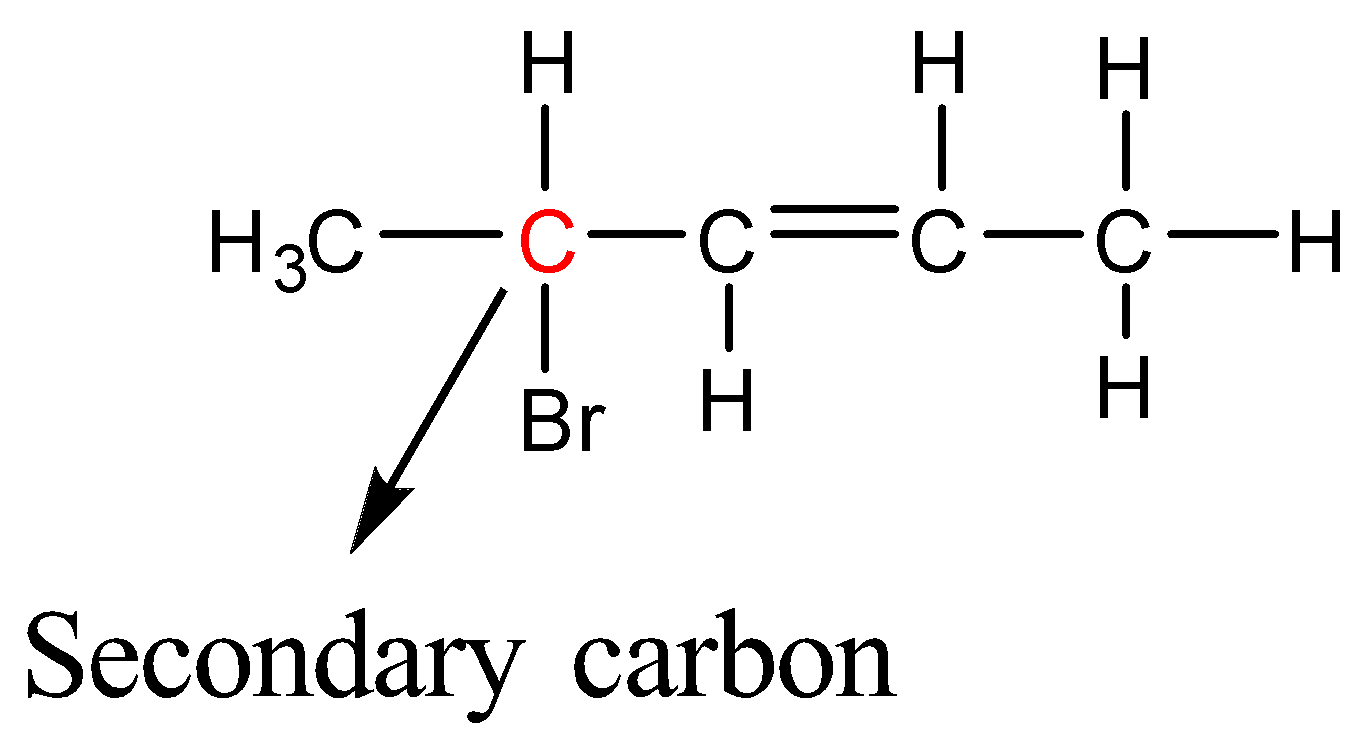
Answer
465.9k+ views
Hint: In primary halides, the halogen atom is bonded to a primary carbon atom. In secondary halides, the halogen atom is bonded to a secondary carbon atom while in tertiary halide; the halogen atom is bonded to a tertiary carbon atom.
Complete step by step answer:
In order to solve this question, we need to first understand the meaning of primary, secondary and tertiary halides.
Primary Halides: In primary halides, the carbon atom bonded to the halogen atom is bonded to only one carbon atom and the rest are hydrogen atoms or the carbon bonded to the halogen atom is only bonded to hydrogen atoms. More simply, we can say that the halogen atom is bonded to a primary carbon.
Example:

Secondary Halides: In secondary halides, the carbon atom bonded to the halogen atom is bonded to two carbon atoms and one hydrogen atom. More simply, we can say that the halogen atom is bonded to a secondary carbon.
Example:

Tertiary halides: In tertiary halides, the carbon atom bonded to the halogen atom is bonded to three carbon atoms. More simply we can say that the halogen atom is bonded to a tertiary carbon.
Example:

In order to solve this question, we need to draw the structures of the compounds given:
1-Bromobut-2-ene

Here Bromine is bonded to a primary carbon atom; therefore 1-Bromobut-2-ene is a primary halide.
4-Bromopent-2-ene

Here Bromine is bonded to a secondary carbon atom; therefore 4-Bromopent-2-ene is a secondary halide.
2-Bromo-2-methylpropane

Here Bromine is bonded to a tertiary carbon atom; therefore 2-Bromo-2-methylpropane is a tertiary halide. So, the correct answer is “Option D”.
Note: In this question all the names of the organic compound were given in accordance with the IUPAC (International Union of Pure and Applied Chemistry) nomenclature. Therefore in order to draw the structure of the compounds from their names, you should know the rules of the IUPAC nomenclature.
Complete step by step answer:
In order to solve this question, we need to first understand the meaning of primary, secondary and tertiary halides.
Primary Halides: In primary halides, the carbon atom bonded to the halogen atom is bonded to only one carbon atom and the rest are hydrogen atoms or the carbon bonded to the halogen atom is only bonded to hydrogen atoms. More simply, we can say that the halogen atom is bonded to a primary carbon.
Example:

Secondary Halides: In secondary halides, the carbon atom bonded to the halogen atom is bonded to two carbon atoms and one hydrogen atom. More simply, we can say that the halogen atom is bonded to a secondary carbon.
Example:

Tertiary halides: In tertiary halides, the carbon atom bonded to the halogen atom is bonded to three carbon atoms. More simply we can say that the halogen atom is bonded to a tertiary carbon.
Example:

In order to solve this question, we need to draw the structures of the compounds given:
1-Bromobut-2-ene

Here Bromine is bonded to a primary carbon atom; therefore 1-Bromobut-2-ene is a primary halide.
4-Bromopent-2-ene

Here Bromine is bonded to a secondary carbon atom; therefore 4-Bromopent-2-ene is a secondary halide.
2-Bromo-2-methylpropane

Here Bromine is bonded to a tertiary carbon atom; therefore 2-Bromo-2-methylpropane is a tertiary halide. So, the correct answer is “Option D”.
Note: In this question all the names of the organic compound were given in accordance with the IUPAC (International Union of Pure and Applied Chemistry) nomenclature. Therefore in order to draw the structure of the compounds from their names, you should know the rules of the IUPAC nomenclature.
Recently Updated Pages
Write the IUPAC name of the given compound class 11 chemistry CBSE

Write the IUPAC name of the given compound class 11 chemistry CBSE

Write the IUPAC name of the given compound class 11 chemistry CBSE

Write the IUPAC name of the given compound class 11 chemistry CBSE

Write the IUPAC name of the given compound class 11 chemistry CBSE

Write the IUPAC name of the given compound class 11 chemistry CBSE

Trending doubts
Fill the blanks with the suitable prepositions 1 The class 9 english CBSE

Which are the Top 10 Largest Countries of the World?

How do you graph the function fx 4x class 9 maths CBSE

Who was the leader of the Bolshevik Party A Leon Trotsky class 9 social science CBSE

The Equation xxx + 2 is Satisfied when x is Equal to Class 10 Maths

Differentiate between homogeneous and heterogeneous class 12 chemistry CBSE

Difference between Prokaryotic cell and Eukaryotic class 11 biology CBSE

Which is the largest saltwater lake in India A Chilika class 8 social science CBSE

Ghatikas during the period of Satavahanas were aHospitals class 6 social science CBSE




